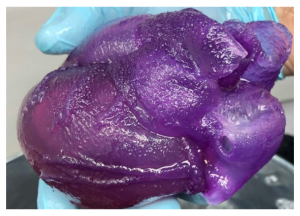
3D bio-printed heart provides new tool for surgeons
May 2, 2021
By Canadian Plastics
Made from a soft, natural polymer called alginate, the full-sized heart model gives surgeons a new tool for planning and practice for heart surgeries.

A completed 3D-bio-printed heart. Photo Credit: Carnegie Mellon University, College of Engineering
Researchers at Carnegie Mellon University in Pittsburgh have used a unique 3D polymer printing technology to create what’s being called the first full-size 3D-printed bio-model of the human heart.
The model – which realistically mimics the elasticity of cardiac tissue and sutures – is designed to give surgeons and physicians practice for heart surgeries and study other heart-related conditions, and was created by Adam Feinberg, a professor in the Departments of Biomedical Engineering and Materials Science and Engineering and his team using a custom Freeform Reversible Embedding of Suspended Hydrogels (FRESH) technique.
The FRESH technique was invented in Feinberg’s lab to satisfy a need for 3D-printed soft polymers, which lack the rigidity to stand unsupported as in a normal print. FRESH 3D printing uses a needle to inject bio-ink into a bath of soft hydrogel, which supports the object as it prints. Once finished, a simple application of heat causes the hydrogel to melt away, leaving only the 3D bio-printed object.
Once FRESH was proven as a printing platform, the Carnegie researchers turned to the task of printing a full-scale human heart. This required that the team build a new 3D printer custom-made to hold a gel support bath large enough to print at the proper scale, as well as minor software changes to maintain the speed and fidelity of the print.
The resulting model is comprised of a soft, natural polymer called alginate, which gives the bio-printed heart characteristics similar to cardiac tissue. For surgeons, this means they can cut, suture, and otherwise manipulate the model in ways similar to a real heart, Feinberg said.
“We can now build a model that not only allows for visual planning, but allows for physical practice,” Feinberg said in a news release. “The surgeon can manipulate it and have it actually respond like real tissue, so that when they get into the operating site they’ve got an additional layer of realistic practice in that setting.”
The Carnegie researchers published a paper on their work in the journal ACS Biomaterials Science and Engineering.
“While major hurdles still exist in bio-printing a full-sized functional human heart, we are proud to help establish its foundational groundwork using the FRESH platform while showing immediate applications for realistic surgical simulation,” added Eman Mirdamadi, one of the Carnegie team members and the lead author on the publication.
Source: Carnegie Mellon University